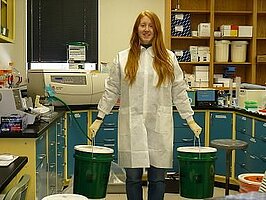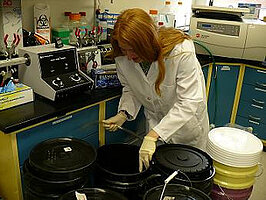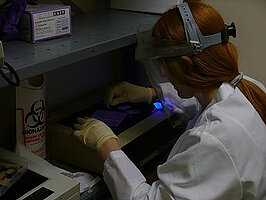Source tracking of Cryptosporidium in rural watersheds

Brianna Schneck is a graduate student (PhD) in the Environmental and Conservation Sciences (ECS) program and NDSU. She completed her B.S. in zoology (emphasis in fisheries, wildlife, ecology, and behavior) from NDSU in May of 2008. Brianna’s main research focuses on source tracking, host-parasite co-evolution, and host specific adaptation of Cryptosporidium in animals.
Brianna.L.Schneck@ndsu.edu
Fellow: Brianna Schneck
Co-Advisors: Dr. John McEvoy, Department of Veterinary and Microbiological Sciences
Dr. Mark Clark, Department of Biological Sciences
Source tracking of Cryptosporidium in rural watersheds
Description and Significance of the project:
The Upper Midwest has among the highest incidences of human cryptosporidiosis in the U.S. (Hlavsa et al. 2005). There is therefore a critical need to determine Cryptosporidium sources and transmission dynamics in this region. A study, which I co-authored, has shown that most human cryptosporidiosis in the region is caused by C. parvum, a species associated with humans and cattle (Feltus et al. 2006). However, the traditional model, describing Cryptosporidium movement from livestock to humans via water, appears over simplistic in light of recent evidence of wildlife sources of contamination. Cryptosporidium species associated with wildlife are not human pathogens and are not a public health threat. To better understand the human health significance of Cryptosporidium in rural watersheds, we need to determine the source of the contamination. I will address this need by quantifying the impact of the wildlife and cattle sources in rural watersheds in the region. With the successful completion of this project, I expect to have clarified the public health significance of waterborne Cryptosporidium in rural watersheds. Outputs from this project will have regional, national, and international relevance and will be critical to the guidance of future policies on the control of Cryptosporidium transmission in water.
Project Objectives:
- Determine the extent of Cryptosporidium host adaptation and co-evolution with hosts. Rationale: While there is compelling qualitative data to support host adaptation and co-evolution, there has been no quantitative data to support this hypothesis. Such quantitative data is critical if host adaptation is to be exploited to accurately determine the source of contamination.
- To determine the factors influencing the contributions of cattle and wildlife to Cryptosporidium in rivers. Rationale: This is critical to understanding the public health significance of Cryptosporidium in rural watersheds.
Progress:
Empirical evidence supports host adaptation and a limited host range for most Cryptosporidium species and genotypes. This knowledge has been used to track sources of water contamination and characterize human health risk; however, the factors affecting host range remain unclear. We are using small mammals (mainly rodent species) as a model to study the effect of factors such as host population density, diversity and behavior on the host range of Cryptosporidium genotypes. Over 250 wildlife fecal samples (from rodent species) have been collected and analyzed over the past year. Trapping grids were set up in various locations near water sources including rivers, streams, and drainage ditches. Cryptosporidium species/genotypes were found in over 40% of the samples. We found that red squirrels, grey squirrels, fox squirrels, and deer mice can carry Cryptosporidium corvine genotype which has been known to affect humans. Deer mice were also found to carry C. parvum, a known human pathogen. Rodents may be a significant source of Cryptosporidium in watersheds. We found a high prevalence of Cryptosporidium species in water samples collected during the major flooding event that affected the Red River Valley in 2009. Nine out of thirteen water samples tested positive for Cryptosporidium. A cattle adapted species, Cryptosporidium andersoni, was found in seven of the nine samples. Cryptosporidium deer mouse III genotype was found in a sample taken from a drainage ditch. We also found DM III in grey squirrels and deer mice. Cryptosporidium suis, a pig adapted species, was also found in a water sample. Livestock contributed significantly to Cryptosporidium contamination in the Red River during a major spring flood.
Publications:
Schneck, B.L., Pennil, C.C., Lanctot, V.T., Giddings, C.W., Clark, M.E., and McEvoy, J.M. 2009 Cryptosporidium genotypes in Midwestern mammals. Poster presented at III International Giardia and Cryptosporidium Conference, Orvieto, Italy, Oct.11-15, 2009.
Pennil, C. C., Clark, M.E., Schneck, B.L., Giddings, C.W., and McEvoy, J.M. 2009. .High prevalence of Cryptosporidium andersoni in surface water during a major spring flooding event. Poster presented at III International Giardia and Cryptosporidium Conference, Orvieto, Italy, Oct.11-15, 2009.
Pennil, C.C., Clark M.E., Giddings C.W., Schneck B.L., and McEvoy J.M. 2009. Determining sources of Cryptosporidium in a rural watershed. Master.s Thesis (Chapter 2), North Dakota State University, Fargo, North Dakota, Chapter 2.



John McEvoy
AES Microbiological Sciences
Office: VanEs 132A
Telephone: 701-231-8530
Email: john.mcevoy@ndsu.edu

Mark Clark
Biological Science
Office: Stevens 119
Telephone: 701-231-8246
Email: m.e.clark@ndsu.edu


